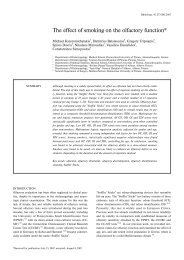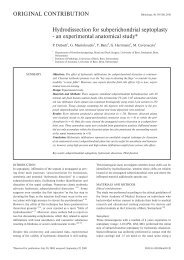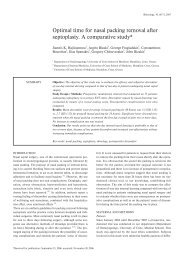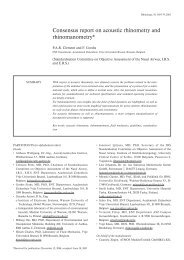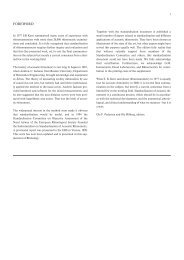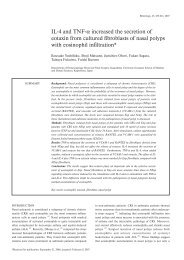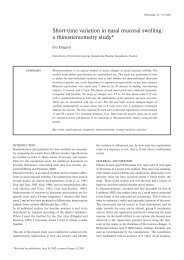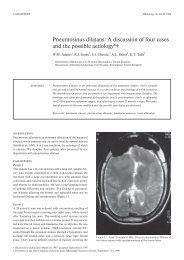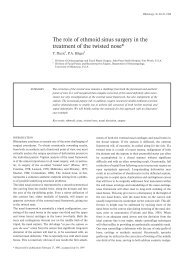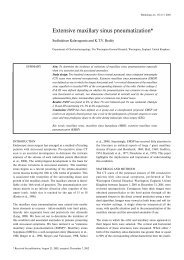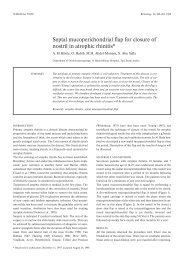Early depictions of the nasal turbinates in the 15th century ...
Early depictions of the nasal turbinates in the 15th century ...
Early depictions of the nasal turbinates in the 15th century ...
You also want an ePaper? Increase the reach of your titles
YUMPU automatically turns print PDFs into web optimized ePapers that Google loves.
Maxillary pneumos<strong>in</strong>us dilitans 169<br />
<strong>in</strong>g 'Sagittal section <strong>of</strong> skull' (Clark 19057r/FB 40 r), we see <strong>the</strong><br />
right half <strong>of</strong> <strong>the</strong> skull where <strong>the</strong> <strong>nasal</strong> floor, <strong>the</strong> lateral <strong>nasal</strong><br />
wall with <strong>the</strong> <strong>in</strong>ferior turb<strong>in</strong>ate, <strong>the</strong> frontal base, and <strong>the</strong><br />
frontal s<strong>in</strong>us are clearly depicted (Figure 3, bottom).<br />
Leonardo's comment <strong>in</strong> mirror-writ<strong>in</strong>g on <strong>the</strong> left-hand side <strong>of</strong><br />
<strong>the</strong> draw<strong>in</strong>g does not mention <strong>the</strong> <strong>in</strong>ferior turb<strong>in</strong>ate: “Where<br />
<strong>the</strong> l<strong>in</strong>e a m, <strong>in</strong>tersects <strong>the</strong> l<strong>in</strong>e c b, will be <strong>the</strong> confluence <strong>of</strong><br />
all senses; ... understand <strong>the</strong> whole.”<br />
Figure 4. Draw<strong>in</strong>g by da V<strong>in</strong>ci, 1489 (Clark 19058v; from O’Malley, 1952).<br />
translation from O’Malley & Saunders, 1952). On <strong>the</strong> left half<br />
<strong>of</strong> <strong>the</strong> skull, <strong>the</strong> draw<strong>in</strong>g shows, <strong>in</strong> precise detail, <strong>the</strong> supraorbital<br />
and <strong>the</strong> supratrochlear foram<strong>in</strong>a, <strong>the</strong> foram<strong>in</strong>a nutricia <strong>of</strong><br />
Figure 3. Draw<strong>in</strong>g by da V<strong>in</strong>ci, 1489 (Clark 19057r; from O’Malley,<br />
1952).<br />
In his draw<strong>in</strong>g ‘Anterior view <strong>of</strong> skull with frontal and maxillary<br />
s<strong>in</strong>us exposed’ (Clark 19058v/FB 41v), <strong>the</strong> maxillary an<br />
frontal s<strong>in</strong>uses, <strong>the</strong> <strong>nasal</strong> cavity, and <strong>the</strong> roots <strong>of</strong> teeth <strong>in</strong> <strong>the</strong><br />
upper and lower jaw have been exposed on <strong>the</strong> right half <strong>of</strong> <strong>the</strong><br />
specimen (Figure 4). Besides <strong>the</strong> foramen <strong>of</strong> <strong>the</strong> right <strong>in</strong>fraorbital<br />
nerve <strong>in</strong> <strong>the</strong> orbital floor and <strong>the</strong> nasolacrimal duct, <strong>the</strong><br />
draw<strong>in</strong>g also shows part <strong>of</strong> <strong>the</strong> <strong>in</strong>ferior turb<strong>in</strong>ate and <strong>the</strong> right<br />
<strong>in</strong>cisive foramen <strong>in</strong> <strong>the</strong> <strong>nasal</strong> floor. Aga<strong>in</strong>, Leonardo’s comment<br />
does not mention <strong>the</strong>se anatomical details: “The cavity<br />
<strong>of</strong> <strong>the</strong> orbit and <strong>the</strong> cavity <strong>of</strong> <strong>the</strong> bone which supports <strong>the</strong><br />
cheek, and that <strong>of</strong> <strong>the</strong> nose and <strong>of</strong> <strong>the</strong> mouth, are <strong>of</strong> equal<br />
depth and term<strong>in</strong>ate <strong>in</strong> a perpendicular l<strong>in</strong>e below <strong>the</strong> sensus<br />
communis; and each <strong>of</strong> <strong>the</strong>se cavities is as long as <strong>the</strong> third<br />
part <strong>of</strong> a man’s face, that is from <strong>the</strong> ch<strong>in</strong> to <strong>the</strong> hair.” (English<br />
Figure 5. Woodcut by Georg Thomas, 1536 (from Herrl<strong>in</strong>ger, 1981).



